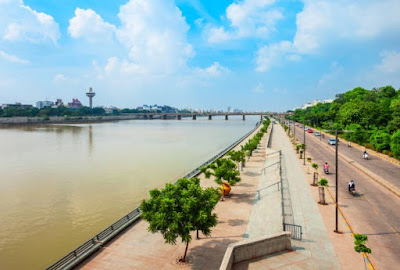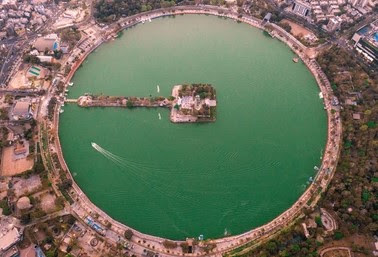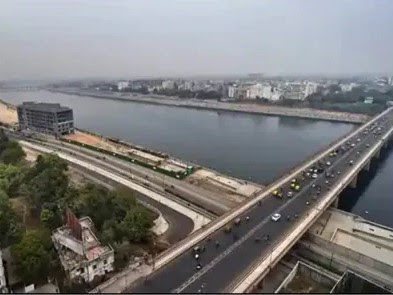Ahmedabad
History :
Ahmedabad is the biggest city in the Province of Gujarat and the Seventh-biggest metropolitan agglomeration in India, with a populace of very nearly 74 lakhs (7.4 Million). City is Situated on the banks of the Waterway Sabarmati. The city, which serves as the district's administrative hub and served as Gujarat's capital from 1960 to 1970, After that, Gandhinagar became the new capital. In the first half of the 20th century, the city was at the forefront of the Indian independence movement. It was the focal point of many missions of common insubordination to advance specialists' right, social liberties and political freedom. Additionally, Mahatma Gandhi chose Ahmedabad as his "Karmabhumi" and established the Gandhi Ashram on the Sabarmati River.
By its namesake, Sultan Ahmed Shah, the city was established in 1411 to serve as the capital of the Sultanate of Gujarat. Under English rule, a tactical Cantonment was laid out and the city framework was modernized and extended. It was important for the Bombay Administration during the English principles in India. Kankaria Lake, in the neighborhood of Maninagar, is a counterfeit lake created by Qutb-ud-clamor Aibak, the Ruler of Delhi, in 1451 A.D. The city is likewise called Karnavati, a name for a more seasoned town that existed in the walled region.
The most important city in Gujarat remained Ahmedabad. The City became known as "The Manchester of India" because it was home to a thriving textile industry. Ahmedabad rose to prominence as the state's political and commercial capital after Gujarat became a state in 1960. The city, once known for its dusty roads and crowded neighborhoods, is now experiencing a significant construction boom and population growth. A rising focus of schooling, data innovation and logical businesses, Ahmedabad stays the social and business heart of Gujarat, and a lot of western India. Skyscrapers, shopping malls, and multiplexes have all contributed to the city's transformation since 2000.
The BRTS and the Sabarmati Stream Front improvement project are additionally under progress. Kankaria Lake, Siddi Saiyad's Jali, Jama Masjid, Roza of Sarkhej are the verifiable landmarks/places arranged in the city. Abhay Ghat, Gandhi Ashram (formerly the Samadhi). Science City, the Vaishnovdevi Temple, and the ISCON Temple are also well-known tourist attractions. Lothal, Step-Well of Adalaj and Akshardham Sanctuary are additionally extremely renowned vacationer puts close by. A well known Swaminarayan Sanctuary is likewise arranged in Sarangpur of Barvala Taluka of Botad Region, which is a recently made locale from parts of Ahmedabad and Bhavnagr. Nal Sarovar Lake is likewise a well known Bird Safe-haven where transient birds from Focal Asia visit consistently in winter season, is arranged in the Ahmedabad Region.
Cultural Heritage:
Ahmedabad is renowned for its cultural diversity and traditions. The city is a melting pot of various communities, including Gujaratis, Muslims, Jains, and more. It is known for its vibrant festivals, arts, crafts, and traditional cuisine.
Architectural Marvels:
The city is home to several architectural marvels that showcase a blend of Islamic, Hindu, and Jain influences. Some notable landmarks include the Sabarmati Ashram, Jama Masjid, Sidi Saiyyed Mosque, Sarkhej Roza, Adalaj Stepwell, and the Hutheesing Jain Temple.
Textile Industry:
Ahmedabad has a thriving textile industry and is often referred to as the "Manchester of the East." The city is known for its traditional textile craftsmanship, including intricate handloom work, tie-dye (bandhani), and block printing. Visitors can explore textile museums, markets, and workshops to learn about the region's textile heritage.
Vibrant Markets:
Ahmedabad is famous for its bustling markets and bazaars. The old city area, known as the "walled city," is home to numerous vibrant markets, including Manek Chowk, Rani no Hajiro, and Law Garden Market. These markets offer a wide range of products, including textiles, handicrafts, jewelry, and traditional Gujarati snacks.
Food:
Ahmedabad is a paradise for food lovers. The city offers a diverse range of culinary delights, including Gujarati thali (a platter of various vegetarian dishes), street food like khaman dhokla, fafda, jalebi, and the famous Gujarati snacks like khandvi and theplas.
Educational Institutions:
Ahmedabad is also a significant educational hub, with renowned institutions such as the Indian Institute of Management (IIM Ahmedabad), Gujarat University, and the National Institute of Design (NID).
Festivals and Events:
The city celebrates various festivals with great enthusiasm, including Uttarayan (Kite Festival), Navratri (nine nights of dance and music), Diwali (Festival of Lights), and the International Kite Festival, which attracts kite enthusiasts from around the world.
Modern Infrastructure:
In recent years, Ahmedabad has witnessed rapid development and modernization. The city boasts modern infrastructure, including shopping malls, multiplexes, parks, and recreational centers.
Accessibility:
Ahmedabad is well-connected by air, rail, and road. It has an international airport, Sardar Vallabhbhai Patel International Airport, which connects it to major cities in India and other countries. The city has a well-developed public transportation system, including buses, auto-rickshaws, and taxis.
Attractions :
Ahmedabad, the cultural and historical hub of Gujarat, offers a variety of attractions for visitors. Here are some notable places to visit in Ahmedabad:
Sabarmati Ashram:
Also known as the Gandhi Ashram, it was the residence of Mahatma Gandhi during the Indian independence movement. The ashram now serves as a museum dedicated to Gandhi's life and teachings.
Jama Masjid:
One of the oldest mosques in Ahmedabad, Jama Masjid showcases stunning architecture with intricate designs and minarets. It is a significant religious and historical site.
Sarkhej Roza:
A complex of tombs, mosques, and a palace, Sarkhej Roza is an architectural marvel. It is a blend of Islamic and Hindu architectural styles and is a popular spot for history and architecture enthusiasts.
Kankaria Lake:
A man-made lake built in the 15th century, Kankaria Lake offers recreational activities such as boating, toy train rides, and a zoo. The lakefront also has gardens, food stalls, and an amusement park.
Sidi Saiyyed Mosque:
Known for its famous stone lattice work windows called "Sidi Saiyyed Jali," this mosque is a masterpiece of Indo-Islamic architecture. The intricate carvings attract visitors from around the world.
Adalaj Stepwell:
Located on the outskirts of Ahmedabad, Adalaj Stepwell is a stunning five-story stepwell known for its intricate carvings. It served as a resting place and water source during ancient times.
Science City:
A modern science-themed entertainment complex, Science City offers interactive exhibits, an IMAX theater, a planetarium, and a variety of educational activities for visitors of all ages.
Calico Museum of Textiles:
Considered one of the finest textile museums in the world, the Calico Museum showcases a remarkable collection of Indian textiles, including rare and ancient pieces.
Ahmedabad Heritage Walk:
Embark on a guided heritage walk through the old city of Ahmedabad to explore its narrow lanes, historical buildings, and bustling markets. The walk takes you to places like Bhadra Fort, Swaminarayan Temple, and the famous Manek Chowk.
Law Garden Market:
A vibrant street market known for its traditional handicrafts, textiles, and jewelry. It's a great place to shop for souvenirs and experience the local culture.
Ahmedabad's Strengths :
- Ahmedabad GDP pegged at 64 billion USD in 2012.
- 3rd fastest growing city as per the Forbes magazine 2010.
- A Times of India survey ranks Ahmedabad City as India's Best City live-in in terms of infrastructure.
- Major base of trade, commerce and industry and engine of industrial and financial growth of the state.
- Ahmedabad will be the First Indian City to receive UNESCO's World Heritage City Status- Tentative Application accepted by UNESCO for the same.
- Quality Water, Sanitation, and Sewerage Services
- Quality Public Transport System
- Financially well managed City Government
- Inclusive city that accommodates the urban poor with sensitivity.
- Ecologically friendly & Energy efficient
- Compact city with short travelling distances.
- Capitalizing on strong economic drivers to create growth and jobs.





0 Comments